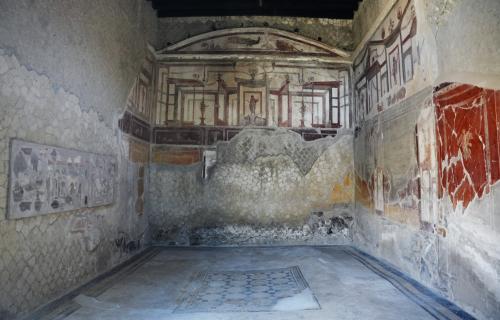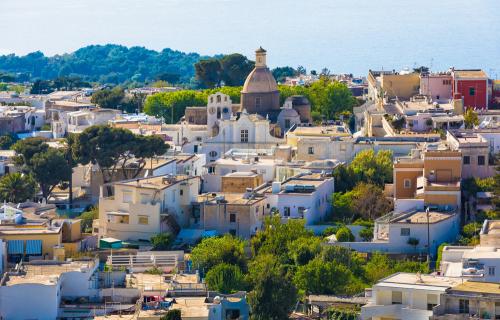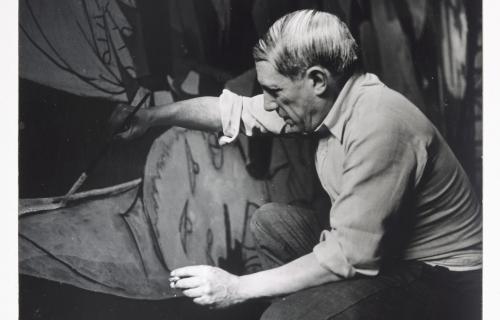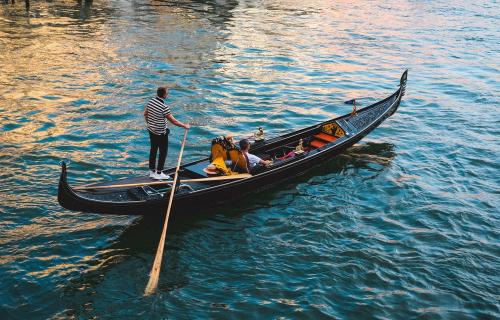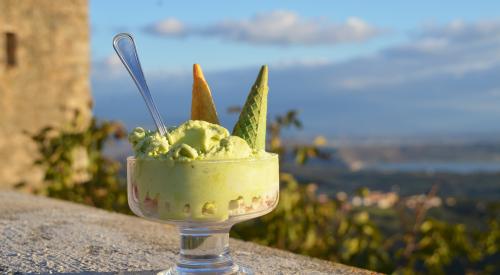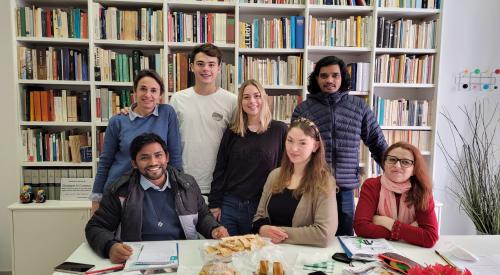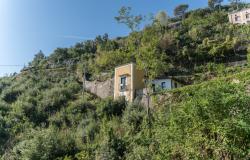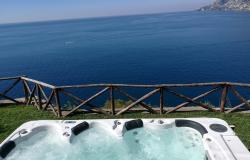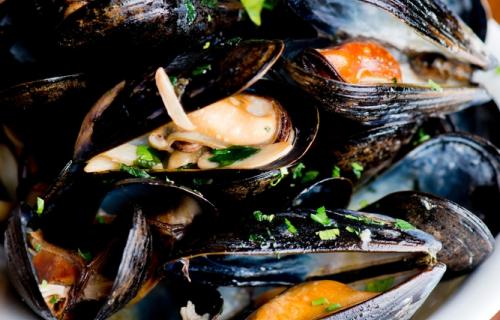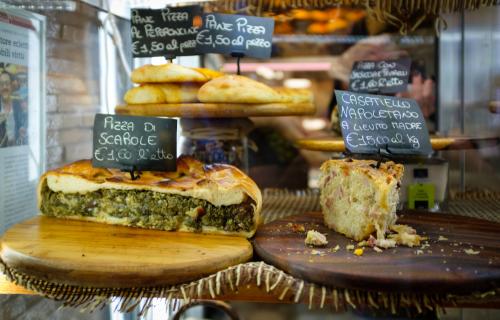I am attempting to translate my greatgrandfather's 1873 Birth Certificate. The two highlighted words in the image below are confusing me. My translation is:
Naples (Campania)
Our Essential Guides aim to give you an introductory overview to a region, city or geographical area. For a deeper dive into Naples and the surrounding area in Campania, check out the Campania issue of Bellissimo, our quarterly e-magazine for Premium Members.
The Essential Guide to Naples
The third largest city in Italy, Naples sits on the Bay of Naples, overlooked by Mount Vesuvius, the still-active volcano that destroyed the nearby ancient Roman town of Pompeii in 79 CE. Dating to the 2nd millennium BCE, Naples has centuries of important art and architecture. Its centro storico (historic center) is a Unesco World Heritage site. Don’t be afraid to get lost among its bustling, narrow streets. Grab a bite to eat from one of the many street food vendors, eat Neapolitan pizza at one of the many esteemed traditional pizzerias, partake in the tradition of caffè sospeso, step inside an artisan workshop to see traditional craftspeople at work, or visit one of the many churches, including the city's cathedral, the Duomo di San Gennaro, filled with frescoes. Other major landmarks include the lavish Royal Palace and Castel Nuovo, a 13th-century castle. Culinarily, Naples is synonymous with pizza, which originated in the city. Neapolitan music has furthermore been highly influential, credited with the invention of the romantic guitar and the mandolin, as well as notable contributions to opera and folk standards. Popular characters and historical figures who have come to symbolize the city include Januarius, the patron saint of Naples, the comic figure Pulcinella, and the Sirens from the Greek epic poem the Odyssey. According to CNN, the metro stop "Toledo" is the most beautiful in Europe. To really know the city, one should also experience some of the mundane and sometimes quirky rituals Neapolitans bequeath from across the ages.
Best times to visit Naples
The mild temperatures common to all of southern Italy make Naples a pleasant destination to visit year round. The best seasons to visit are spring and fall (with Naples’s famous pizza festival taking place in the fall, between September and October).
Summer can be very hot and crowded, with visitors using Naples as a gateway to Pompeii, Ischia, Capri and the Amalfi Coast. However, summer is also when a great number of open-air festivals and events take place, with the streets of Naples very much alive through the night, so if that is your thing take it into consideration
Visiting in winter can be a very smart choice, as temperatures are generally mild with frequent sunny days, while museums and archaeological sites nicely free from crowds. As an added bonus, hotel rates are lower. And the experience of visiting San Gregorio Armeno, aka “la via dei presepi,” where artisans handcraft the characters of the Neapolitan nativity scene is hard to surpass as a quintessential Neapolitan experience.
Traveling to Naples: how to get there
The easiest way to get to Naples is by high-speed train. Naples' main train station is called Napoli Centrale, served by both Trenitalia (Italy's national rail company) and Italo. Naples is well connected by train to major Italian cities, with traveling time from Rome only one hour and 15 minutes.
Naples’s main airport, Capodichino International Airport, only 3 km from the city center, is served by a number of direct national and international flights, with the highest number of routes in summer. Rome’s larger Fiumicino and Ciampino airports are less than 200 km away. Naples International Airport is connected to the city by bus.
Naples can also be reached by car via the A1, or Autostrada del Sole, which runs the entire length of Italy. From Rome, it’s about 2 hours and 30 minutes.
*Check our ultimate guide to train travel in Italy.
How to get around in Naples
The best way to see Naples is on foot. The city’s main tourist attractions are located along the seafront and in the historic center, so that makes it easy to get around on foot.
The extensive public transportation system includes Metro trains, buses, and even funiculars if you need to reach the hills.
Regional trains and buses connect visitors to Pompeii, Herculaneum, Sorrento and towns on the Amalfi Coast. The Circumvesuviana train, a local commuter train, departs every 20 minutes from Napoli Centrale railway station and takes about an hour to reach Sorrento.
It can be complicated to reach other towns on the Amalfi Coast by public transport as the bus doesn’t run frequently, while ferries to Positano only run in the summer season. The easiest way is to book a private transfer.
Ferries run between Naples and Capri all year round, departing from Molo Beverello (hydrofoils) or Calata Porta di Massa (regular ferries) piers. Molo Beverello (where hydrofoils also leave for Sorrento) is located in Piazza Municipio in the city center, while Porta di Massa is located closer to the train station.
Driving in Naples isn’t recommended; parking is scarce, traffic a nightmare, and the narrow, one-way streets can be challenging to navigate.
What to see in Naples
Duomo - Located in the very heart of the historic center, the Cathedral of Naples is very dear to the Neapolitans because it’s dedicated to the cult of San Gennaro, patron saint of the city. Before you enter, take a moment to admire the majestic facade, in Angevin Gothic style, built in the 13th century. Inside, admire the chapels built over the centuries by powerful Neapolitan families, as well as paintings by Luca Giordano depicting the Apostles, the Fathers and the Doctors of the Church.
Royal Chapel of the Treasure of San Gennaro - This is the most lavishly decorated chapel inside the Cathedral, with contributions by premier Baroque artists in Naples. The museum dedicated to the Saint contains relics, precious objects, statues, candlesticks and silver coins, which devotees have jealously protected during the numerous looting of the city over the centuries. The most precious object is however a vial of what is thought to be the blood of San Gennaro; it is brought out three times a year, when the miracle of San Gennaro - his dried blood liquefying - is expected. If that doesn’t happen, legend has it that disaster will befall Naples.
Spaccanapoli - This is perhaps the most famous street in Naples. The name comes from the fact that this street literally ‘splits’ the historic center of Naples in two parts (spacca = splits). In Spaccanapoli, you will find ancient buildings and churches enveloped in legend, interspersed with the unmistakable scent of Neapolitan cuisine. Indeed, Spaccanapoli features some of the best bars, pizzerias, pastry shops and small restaurants where you can try typical Neapolitan food. Among the attractions not to miss in Spaccanapoli are the Piazza and Church of Gesù Nuovo, the monumental complex of Santa Clara, Piazza San Domenico Maggiore, the Sansevero Chapel with the Veiled Christ, Piazzetta Nilo, San Gregorio Armeno, especially famous for its artisans, the Basilica of San Lorenzo Maggiore, and Underground Naples.
Cappella San Severo and the Veiled Christ - This baroque chapel contains Giuseppe Sanmartino's incredible sculpture, Cristo velato. According to legend, the veil of marble on the body of Christ is a veil of fabric, transformed into rock by a concoction invented by an illustrious alchemist, the sinister Prince of San Severo. But the incredibly realistic effect of the veil is actually due to the talent of sculptor Sanmartino.
Church of Gesù Nuovo - Among the 500 or so churches in Naples, the church of Gesù Nuovo, in the middle of Spaccanapoli, is among the most beloved and frequented by the Neapolitans. It was originally a palace built in 1470 by the Prince of Salerno Roberto Sanseverino and one of the best examples of Neapolitan Baroque.
Piazza del Plebiscito - This is a landmark square of Naples, the largest in the city and one of the largest in Italy. Over the centuries, it has transformed from a simple country road into a meeting place for Neapolitans, a large pedestrian square surrounded by the neoclassical colonnade of the Church of San Francesco di Paola.
Royal Palace of Naples - Sitting on Piazza del Plebiscito, it was built in the late 1500s to host King Philip III. The construction was commissioned to Domenico Fontana in 1600, who delivered it in just two years. Inside the Palace, highlights include the Royal Apartment, the Royal Chapel, the gardens and the Court Theater.
Via San Gregorio Armeno - The famous street where ancient artisan workshops crafting Nativity characters and scenes are sold. Via San Gregorio Armeno has long been a commercial hub: in the Greek-Roman era, the area around the street, especially what is today San Gaetano square, was the center of Neapolis’ political and administrative life. It was also the city’s artistic heart, where workshops of painters, sculptors, carvers, and goldsmiths were based; with their art, they embellished Naples’ churches and palaces.
MANN (Museo Archeologico Nazionale di Napoli) - The National Archeological Museum of Naples is considered one of the most important archeological museums in the world, and the most important when it comes to ancient Rome. With its 250,000 works of art and objects covering five centuries of history over a 21,000-square-meter space, a visit to the MANN is a trip into the world of ancient civilizations. The museum indeed stands out for its impressive collection of Greek and Roman antiquities.
Underground Naples - Its origins date back several centuries, when tuff stone was extracted as building material, thus leading to the creation of an enormous network of tunnels and caves that ended up being used by Neapolitans in different eras. Today, you can visit Underground Naples via two main routes: from Via dei Tribunali, you access the classic route that crosses the Greco-Roman aqueduct, the air-raid shelters, the War Museum, the underground gardens and the Arianna seismic station. Or you can visit the Roman Theater, which is accessed from a private house by moving a bed under which a door is hidden.
Castel Nuovo - Also known as Maschio Angioino, Castel Nuovo is a medieval castle built in 1266 by Charles I of Anjou. The fortress was built to become the royal residence for the rulers of the House of Anjou, and was called ‘Castrum novum’, to distinguish it from the three already existing castles, Castel Sant’Elmo, Castel dell’Ovo and Castel Capuano.
Castel dell’Ovo - A seaside castle located on the peninsula of Megaride, an enchanted place that offers a marvelous view of the Gulf of Naples; the perfect way to wrap up your day visit of the city. Castel dell’Ovo is located in a very beautiful area of Naples, near via Caracciolo where, in summer, you can see Neapolitans sunbathing and diving into the sea, right near the castle, while enjoying one of the most beautiful views you get in Naples.
Lungomare - Naples’ seafront promenade along the Mediterranean Sea is the most popular place for the evening passeggiata, and is especially alive on Sundays and in summer. Stroll the Lungomare to see the busy Naples port and admire the many ships that dock in the harbor.
What to eat in Naples
Naples is the hometown of pizza, so the first thing you may want to do when you arrive is find a traditional Neapolitan pizzeria. According to popular tradition, in 1889, 28 years after the unification of Italy, during a visit to Naples of Queen Margherita of Savoy, wife of King Umberto I, chef Raffaele Esposito of Pizzeria Brandi and his wife created a pizza resembling the colors of the Italian flag, red (tomato), white (mozzarella) and green (basil). They named it after the Queen - Pizza Margherita. Since 2009, Pizza Margherita is one of the three Pizze Napoletane with an STG (Specialità Tradizionali Garantite - Traditional Guaranteed Specialty) EU label together with the Marinara (garlic and oregano) and the Margherita Extra (mozzarella di Bufala Campana DOP, fresh basil and tomatoes).
You may not be as familiar with “the other Neapolitan pizza”, pizza fritta, a must try. The quintessential street food before street food became a thing, pizza fritta originated in the aftermath of World War II as a cheap alternative to regular pizza. Flash-fried for a crisp outside and gooey center, it can be filled with virtually anything, from traditional cicoli (pork fat) and ricotta or provolone cheeses to broccoli rape; but it’s wonderful also just plain.
Coffee culture in Naples is big. Traditions around coffee abound: ‘caffé sospeso,’ a cup of coffee paid in advance anonymously for another customer; ‘caffé di ginocchio’, a practice that spread between 1800 and 1900, when the barista roasted used grounds again in order to sell the coffee at a reduced price to those who couldn't afford it; ‘il caffè della consolazione,’ when neighbors and relatives give coffee as a way to comfort someone after a loss. It was only with the invention of the caffettiera napoletana in the 19th century that coffee really took off in Naples. Drink a true Neapolitan coffee made with the cuccuma, the traditional Neapolitan flip coffee pot, at the elegant Gran Caffè La Caffettiera.
While not made in Naples proper, buffalo mozzarella is another must try. Produced using exclusively fresh whole buffalo milk, it is made at breeding farms located in the certified area that comprises mostly the provinces of Caserta and Salerno.
You cannot leave Naples without sampling sfogliatella, one of the city’s most traditional pastries. While its origins remain uncertain, this irresistible shell-shaped sweet treat has stood the test of time. Sfogliatella is made by rolling out dough and forming it into a log, then trimming the ends so that the layers separate when baked, creating flaky ‘leaves.’ It is filled with cream and topped with a dusting of powdered sugar.
Guide last updated by Silvia Donati, 2022
Campania Highlights
What you can't miss in Campania
Where is Naples
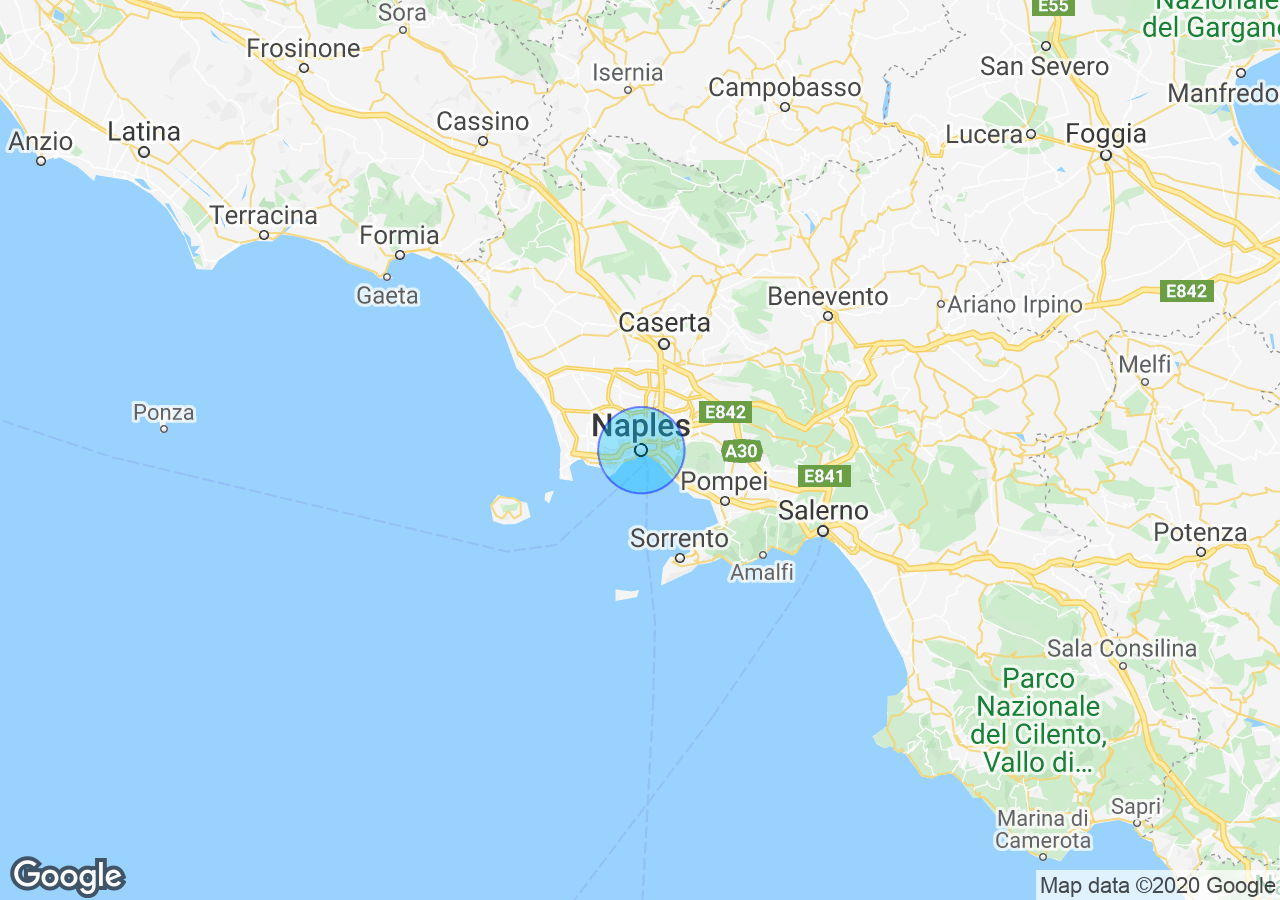
Top Experiences in Campania
Properties for sale in Campania
Recipes From Campania
What others are saying about Campania
Hello all,
I am wondering if anyone can give any guidance on if there are licensed architects or drafts-persons who can work virtually with owners on drawing plans for home renovation in Italy (Naples)
Any insight to this process would be so helpful.
ND
What is the fax machine number for torre del Greco commune?
I want to get a birth certificate for dual citizenship by blood.
I keep faxing to this number but it fails.
+39 0818-491655



